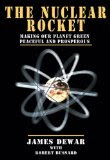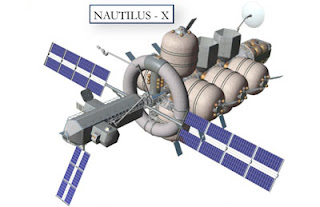Nuclear Rockets In The Atmosphere?
In James Dewar's latest book he proposes the development of a new solid core highly enriched uranium rocket engine based on the B-4 core developed in the Rover/NERVA program, but unlike that program he recommends starting small, testing in a dedicated exhaust processing facility and building successive generations of engine to prove safety and gain operational experience.
The first engine to be put into operation would have 40,000lbf (800MW), an ISP of 1,000s and weigh 6,000lb. It would have a maximum burn time of 15 minutes. The gross mass for the stage would be 91,000lb with 45,000lb of LH2 fuel, and a 3,000lb cocoon to recover the engine, to deliver a 17,000lb payload to LEO*. The stage would be dropped from 50,000ft by a cargo plane (such as the C-5A), and solid rocket boosters would carry it to 100,000ft before the solid core engine engages. The deorbited engine in its cocoon would be recovered from a splashdown for processing, as the U-235 would only be ~1% spent in the short burn required for orbital insertion.
This is just the first operational vehicle, bigger payloads to justify the cost would follow - Dewar makes recommendations for other rocket engines in the book, but this is his pièce de résistance.
Obviously, there are a lot of political issues to overcome before this could ever be funded at a government level and, excluding Bond villains, it almost certainly would have to be a government program. But what are the technical arguments against this? What are the (non-nuclear-hysteria) safety arguments?
And, to counterbalance the risk, are there good arguments for such a program?
These are not rhetorical questions, I want your opinion.
* in metric: 177,929N (800MW), 2,722kg. Gross mass for the stage would be 41,277kg with 20,412kg of LH2 fuel, and a 1,361kg cocoon, to deliver a 7,711kg payload to LEO.
The first engine to be put into operation would have 40,000lbf (800MW), an ISP of 1,000s and weigh 6,000lb. It would have a maximum burn time of 15 minutes. The gross mass for the stage would be 91,000lb with 45,000lb of LH2 fuel, and a 3,000lb cocoon to recover the engine, to deliver a 17,000lb payload to LEO*. The stage would be dropped from 50,000ft by a cargo plane (such as the C-5A), and solid rocket boosters would carry it to 100,000ft before the solid core engine engages. The deorbited engine in its cocoon would be recovered from a splashdown for processing, as the U-235 would only be ~1% spent in the short burn required for orbital insertion.
This is just the first operational vehicle, bigger payloads to justify the cost would follow - Dewar makes recommendations for other rocket engines in the book, but this is his pièce de résistance.
Obviously, there are a lot of political issues to overcome before this could ever be funded at a government level and, excluding Bond villains, it almost certainly would have to be a government program. But what are the technical arguments against this? What are the (non-nuclear-hysteria) safety arguments?
And, to counterbalance the risk, are there good arguments for such a program?
These are not rhetorical questions, I want your opinion.
* in metric: 177,929N (800MW), 2,722kg. Gross mass for the stage would be 41,277kg with 20,412kg of LH2 fuel, and a 1,361kg cocoon, to deliver a 7,711kg payload to LEO.



This comment has been removed by a blog administrator.
ReplyDeleteIf any technology has the raw power to build a new propulsion system its Nuclear, but the downside of that technology is inescapable. I doubt that the risk of using U-235 would ever "fly" given the energetic system that is necessary to put something meaningful into orbit can also distribute its contents so widely. There is no need for a terrorist dirty bomb if we do it to ourselves willingly.
ReplyDeleteThat being said, there is one other technology that could be used that has not been investigated in depth, and that is the energy generation technology going on at blacklightpower.com. It's revolutionary if it really works, and there is significant evidence that it does. One previous study from Nasa determined that there was enough evidence to suggest that a propulsion system could/might be built which would be worth the effort to look into. While this technology won't deliver the magnitude of energy that Nuclear will, it still far exceeds that of chemical power alone. The unfortunate circumstances are that few people will take it seriously because of all the scientific back-pressure from the cold fusion fiasco. Nobody wants to stick their neck out and take the chance that it really works.
http://www.niac.usra.edu/files/studies/final_report/752Marchese.pdf
SteveC, thanks for showing Victor the line between quirky and outright crazy.
ReplyDelete